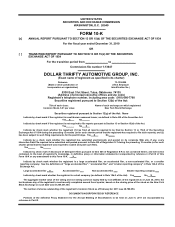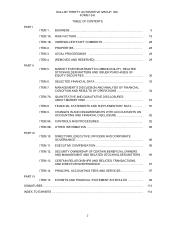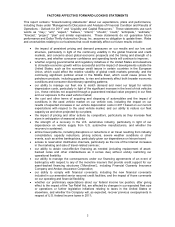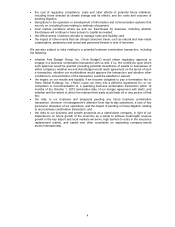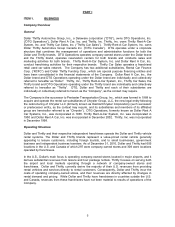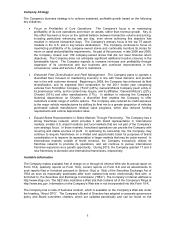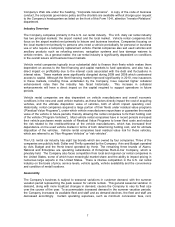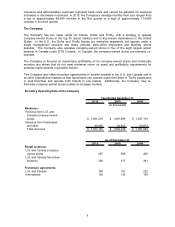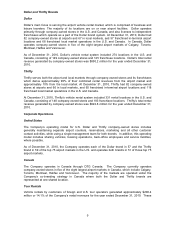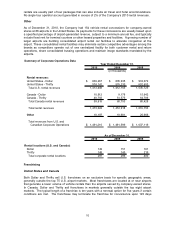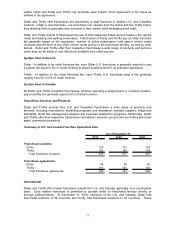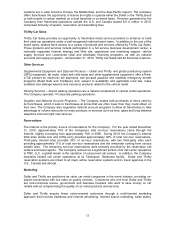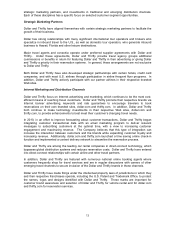Thrifty Car Rental 2010 Annual Report Download - page 4
Download and view the complete annual report
Please find page 4 of the 2010 Thrifty Car Rental annual report below. You can navigate through the pages in the report by either clicking on the pages listed below, or by using the keyword search tool below to find specific information within the annual report.FACTORS AFFECTING FORWARD-LOOKING STATEMENTS
This report contains “forward-looking statements” about our expectations, plans and performance,
including those under “Management’s Discussion and Analysis of Financial Condition and Results of
Operations - Outlook for 2011” and “Liquidity and Capital Resources.” These statements use such
words as “may,” “will,” “expect,” “believe,” “intend,” “should,” “could,” “anticipate,” “estimate,”
“forecast,” “project,” “plan” and similar expressions. These statements do not guarantee future
performance and Dollar Thrifty Automotive Group, Inc. assumes no obligation to update them. Risks
and uncertainties relating to our business that could materially affect our future results include:
x the impact of persistent pricing and demand pressures on our results and our low cost
structure, particularly in light of the continuing volatility in the global financial and credit
markets, and concerns about global economic prospects and the timing and strength of a
recovery, and whether consumer confidence and spending levels will continue to improve;
x whether ongoing governmental and regulatory initiatives in the United States and elsewhere
to stimulate economic growth will be successful and the impact of developments outside the
United States, such as the sovereign credit issues in certain countries in the European
Union, which could affect the relative volatility of global credit markets generally, and the
continuing significant political unrest in the Middle East, which could cause prices for
petroleum products, including gasoline, to rise and adversely affect both broader economic
conditions and consumer discretionary spending patterns;
x our ability to manage our fleet mix to match demand and meet our target for vehicle
depreciation costs, particularly in light of the significant increase in the level of risk vehicles
(i.e., those vehicles not acquired through a guaranteed residual value program) in our fleet
and our exposure to the used vehicle market;
x the cost and other terms of acquiring and disposing of automobiles and the impact of
conditions in the used vehicle market on our vehicle cost, including the impact on our
results of expected increases in our vehicle depreciation costs in 2011 based on our current
expectations with respect to the used vehicle market, and our ability to reduce our fleet
capacity as and when projected by our plans;
x the impact of pricing and other actions by competitors, particularly as they increase fleet
sizes in anticipation of seasonal activity;
x the strength of a recovery in the U.S. automotive industry, particularly in light of our
dependence on vehicle supply from U.S. automotive manufacturers, and whether the
recovery is sustained;
x airline travel patterns, including disruptions or reductions in air travel resulting from industry
consolidation, capacity reductions, pricing actions, severe weather conditions or other
events, such as airline bankruptcies, particularly given our dependence on leisure travel;
x access to reservation distribution channels, particularly as the role of the Internet increases
in the marketing and sale of travel-related services;
x our ability to obtain cost-effective financing as needed (including replacement of asset-
backed notes and other indebtedness as it comes due) without unduly restricting our
operational flexibility;
x our ability to manage the consequences under our financing agreements of an event of
bankruptcy with respect to any of the monoline insurers that provide credit support for our
asset-backed financing structures (“Monolines”), including Financial Guaranty Insurance
Company and Ambac Assurance Corporation;
x our ability to comply with financial covenants, including the new financial covenants
included in our amended senior secured credit facilities, and the impact of those covenants
on our operating and financial flexibility;
x whether our preliminary expectations about our federal income tax position, after giving
effect to the impact of the Tax Relief Act, are affected by changes in our expected fleet size
or operations or further legislative initiatives relating to taxes in the United States or
elsewhere, and whether the Company will, as expected, recover previous overpayments in
respect of U.S. federal income taxes in 2011;
3


